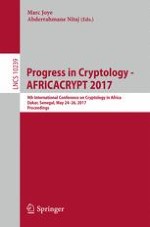2017 | OriginalPaper | Buchkapitel
Efficient Oblivious Transfer from Lossy Threshold Homomorphic Encryption
verfasst von : Isheeta Nargis
Erschienen in: Progress in Cryptology - AFRICACRYPT 2017
Aktivieren Sie unsere intelligente Suche, um passende Fachinhalte oder Patente zu finden.
Wählen Sie Textabschnitte aus um mit Künstlicher Intelligenz passenden Patente zu finden. powered by
Markieren Sie Textabschnitte, um KI-gestützt weitere passende Inhalte zu finden. powered by
